Regional Socioeconomic Changes Affecting Rural Area Livelihoods and Atlantic Forest Transitions
Abstract
1. Introduction
2. Atlantic Forest Cover through Time and the Focus on the Paraíba Valley Region
3. Materials and Methods
3.1. Sampling
3.2. Rural Property Survey
3.3. Data and Analysis
4. Results and Discussion
4.1. Rural Socioeconomic Characterization
4.2. Rural Livelihood Changes and Regional Land Transitions
4.3. Biophisical Variables Driving Land Use Decisions and Affecting Regional Forest Cover Changes
4.4. The Interplay of Rural Population and Environmental Policy with the Forests
4.5. The Fate of Rural Areas and the Regional Forest Transition
5. Conclusions
Author Contributions
Funding
Acknowledgments
Conflicts of Interest
References
- Goldewijk, K.K. Estimating global land use change over the past 300 years: The HYDE database. Glob. Geochem. Cycles 2001, 15, 417–433. [Google Scholar] [CrossRef]
- Washington-Ottombre, C.; Pijanowski, B.; Campbell, D.; Olson, J.; Maitima, J.; Musili, A.; Kibaki, T.; Kaburu, H.; Hayombe, P.; Owango, E.; et al. Using a role-playing game to inform the development of land-use models for the study of a complex socio-ecological system. Agric. Syst. 2010, 103, 117–126. [Google Scholar] [CrossRef]
- Post, W.M.; Kwon, K.C. Soil carbon sequestration and land-use change: Processes and potential. Glob. Chang. Biol. 2000, 6, 317–327. [Google Scholar] [CrossRef]
- Wagner, P.D.; Kumar, S.; Schneider, K. An assessment of land use change impacts on the water resources of the Mula and Mutha Rivers catchment upstream of Pune, India. Hydrol. Earth Syst. Sci. 2013, 17, 2233–2246. [Google Scholar] [CrossRef]
- Pielke, R.A. Land Use and Climate Change. Science 2005, 310, 1625–1626. [Google Scholar] [CrossRef] [PubMed]
- Foley, J.A.; Defries, R.; Asner, G.P.; Barford, C.; Bonan, G.; Carpenter, S.R.; Chapin, F.S.; Coe, M.T.; Daily, G.C.; Gibbs, H.K.; et al. Global consequences of land use. Science 2005, 309, 570–574. [Google Scholar] [CrossRef]
- Lambin, E.F.; Meyfroidt, P. Land use transitions: Socio-ecological feedback versus socio-economic change. Land Use Policy 2010, 27, 108–118. [Google Scholar] [CrossRef]
- Moran, E.F.; Ostrom, E. Seeing the Forest and the Trees: Human-Environment Interactions in Forest Ecosystems; MIT Press: Cambridge, UK, 2005. [Google Scholar]
- Koontz, T.M. Money Talks? But to Whom? Financial Versus Nonmonetary Motivations in Land Use Decisions. Soc. Nat. Resour. Int. J. 2010, 14, 51–65. [Google Scholar]
- Irwin, E.G.; Geoghegan, J. Theory, data, methods: Developing spatially explicit economic models of land use change. Agric. Ecosyst. Environ. 2001, 85, 7–23. [Google Scholar] [CrossRef]
- Areal, F.J.; Riesgo, L. Farmers’ views on the future of olive farming in Andalusia, Spain. Land Use Policy 2014, 36, 543–553. [Google Scholar] [CrossRef]
- Beilin, R.; Lindborg, R.; Stenseke, M.; Pereira, H.M.; Llausas, A.; Slätmo, E.; Cerqueira, Y.; Navarro, L.; Rodrigues, P.; Reichelt, N.; et al. Analysing how drivers of agricultural land abandonment affect biodiversity and cultural landscapes using case studies from Scandinavia, Iberia and Oceania. Land Use Policy 2014, 36, 60–72. [Google Scholar] [CrossRef]
- Silvano, R.A.M.; Udvardy, S.; Ceroni, M.; Farley, J. An ecological integrity assessment of a Brazilian Atlantic Forest watershed based on surveys of stream health and local farmers’ perceptions: Implications for management. Ecol. Econ. 2005, 53, 369–385. [Google Scholar] [CrossRef]
- Panthi, J.; Aryal, S.; Dahal, P.; Bhandari, P.; Krakauer, N.Y.; Pandey, V.P. Livelihood vulnerability approach to assessing Climate change impacts on mixed agro-livestock smallholders around the Gandaki River Basin in Nepal. Reg. Environ. Chang. 2016, 16, 1121–1132. [Google Scholar] [CrossRef]
- Mango, N.; Makate, C.; Tamene, L.; Mponela, P.; Ndengu, G. Adoption of small-scale irrigation farming as a climate-smart agriculture practice and its influence on household income in the Chinyanja Triangle, Southern Africa. Land 2018, 7, 49. [Google Scholar] [CrossRef]
- Ango, T.G.; Borjeson, L.; Senbeta, F.; Hylander, K. Balancing Ecosystem Services and Disservices: Smallholder Farmers’ Use and Management of Forest and Trees in an Agricultural Landscape in Southwestern Ethiopia. Ecol. Soc. 2014, 19, 30. [Google Scholar] [CrossRef]
- Gurri, F.D. Smallholder land use in the southern Yucatan: How culture and history matter. Reg. Environ. Chang. 2010, 10, 219–231. [Google Scholar] [CrossRef]
- Ojha, H.R.; Shrestha, K.K.; Subedi, Y.R.; Shah, R.; Nuberg, I.; Heyojoo, B.; Cedamon, E.; Rigg, J.; Tamang, S.; Paudel, K.P.; et al. Agricultural land underutilization in the hill of Nepal: Investigating socio-environmental pathways of change. J. Rural Stud. 2017, 53, 156–172. [Google Scholar] [CrossRef]
- Ngutu, M.; Bukachi, S.; Olungah, C.O.; Kiteme, B.; Kaeser, F.; Haller, T. The actors, rules and regulations linked to export horticulture production and access to land and water as common pool resources in Laikipia County, Northwest Mount Kenya. Land 2018, 7, 110. [Google Scholar] [CrossRef]
- Rudel, T.K.; Coomesb, O.T.; Moran, E.; Achardd, F.; Angelsene, A.; Xuf, J.; Lambin, E. Forest transitions: Towards a global understanding of land use change. Glob. Environ. Chang. 2005, 15, 23–31. [Google Scholar] [CrossRef]
- Chazdon, R. Tropical Forest Regeneration. Bol. Mus. Pará. Emílio Goeldi Cienc. Nat. 2012, 7, 195–218. [Google Scholar]
- Gray, C.L.; Bilsborrow, R.E. Consequences of out-migration for land use in rural Ecuador. Land Use Policy 2014, 36, 182–191. [Google Scholar] [CrossRef] [PubMed]
- He, J.; Lang, R.; Xu, J. Local Dynamics Driving Forest Transition: Insights from Upland Villages in Southwest China. Forests 2014, 5, 214–233. [Google Scholar] [CrossRef]
- Ferreira, M.P.; Alves, D.S.; Shimabukuro, Y.E. Forest dynamics and land-use transitions in the Brazilian Atlantic Forest: The case of the sugarcane expansion. Reg. Environ. Chang. 2015, 15, 365–377. [Google Scholar] [CrossRef]
- Silva, R.F.B.; Batistella, M.; Moran, E.F. Drivers of land change: Human-environment interactions and the Atlantic forest transition in the Paraíba Valley, Brazil. Land Use Policy 2016, 58, 133–144. [Google Scholar] [CrossRef]
- Loran, C.; Ginzler, C.; Bürgi, M. Evaluating forest transition based on a multi-scale approach: Forest are dynamics in Switzerland 1850–2000. Reg. Environ. Chang. 2016, 16, 1807–1818. [Google Scholar] [CrossRef]
- McConnell, W.J.; Viña, A.; Kull, C.; Batko, C. Forest transitions in Madagascar’s highlands: Initial evidence and implications. Land 2015, 4, 1155–1181. [Google Scholar] [CrossRef]
- Tucker, C.M.; Southworth, J. Processes of Forest Change at the Local and Landscape Levels in Honduras and Guatemala. In Seeing the Forest and the Trees: Human-Environment Interactions in Forest Ecosystems; Moran, E.F., Ostrom, E., Eds.; MIT Press: Cambridge, UK, 2005; pp. 253–277. [Google Scholar]
- Tabarelli, M.; Pinto, L.P.; Silva, J.M.C.; Hirota, M.M.; Bedê, L.C. Challenges and opportunities for biodiversity conservation in the Brazilian Atlantic Forest. Megadiversidade 2005, 1, 132–138. [Google Scholar] [CrossRef]
- Victor, M.A.M.; Cavalli, A.C.; Guillaumon, J.R.; Serra Filho, R. One Hundred Years of Devastation Reviewed Thirty Years After; MMA: Brasília, Brazil, 2005. (In Portuguese) [Google Scholar]
- Lira, P.K.; Tambosi, L.R.; Ewers, R.M.; Metzger, J.P. Land-use and land-cover change in Atlantic Forest landscapes. For. Ecol. Manag. 2012, 15, 80–89. [Google Scholar] [CrossRef]
- SOS Mata Atlântica, Fundação/INPE. Atlas of the Atlantic Forest Remnants in the Period of 2012–2013; Fundação SOS Mata Atlântica/INPE: São Paulo, Brazil, 2014. (In Portuguese) [Google Scholar]
- Borgonovi, M.; Chiarini, J.V.; Amaral, A.Z.; Coelho, G.S.; Oliveira, D.A. Cobertura Vegetal do Estado de São Paulo. Bragantia 1967, 26, 95–102. [Google Scholar] [CrossRef]
- Silva, R.F.B.; Batistella, M.; Moran, E.F.; Lu, D. Land Changes Fostering Atlantic Forest Transition in Brazil: Evidences from the Paraíba Valley. Prof. Geogr. 2017, 69, 80–93. [Google Scholar] [CrossRef]
- Farinaci, J.S.; Batistella, M. Variation on native vegetation cover in São Paulo: An overview of current knowledge. Revista Árvore 2012, 36, 695–705. [Google Scholar] [CrossRef]
- Itani, M.R.; Barros, C.M.; Figueiredo, F.E.L.; Andrade, M.R.M.; Mansor, M.T.C.; Mangabeira, R.L.; Carvalho, V.S. Environmental Planning: Unit of Water Resources Management of Paraíba do Sul; SAM: São Paulo, Brazil, 2011. (In Portuguese) [Google Scholar]
- Soriano, E.; Londe, L.R.; Gregorio, L.T.D.; Coutinho, M.P.; Santos, L.B.L. Water crisis in São Paulo evaluated under the disaster’s point of view. Ambient. Soc. 2016, 19, 21–42. [Google Scholar] [CrossRef]
- Funcate. GHG Emissions from Land Use, Land-Use Change, and Forestry Sector in São Paulo State; CETESB: São Paulo, Brazil, 2012. [Google Scholar]
- Silva, R.F.B.; Batistella, M.; Moran, E.F. Socioeconomic changes and environmental policies as dimensions of regional land transitions in the Atlantic Forest, Brazil. Environ. Sci. Policy 2017, 74, 14–22. [Google Scholar] [CrossRef]
- Aggarwal, C.C. Outlier Analysis; Springer: New York, NY, USA, 2013. [Google Scholar]
- Minella, J.P.G.; Merten, G.H. Topographic Index applied to Agricultural and Environmental Modelling. Ciênc. Rural 2012, 42, 1575–1582. [Google Scholar] [CrossRef]
- Silva, R.F.B.; Ferraz, S.F.B.; Sartori, A.A.C.; Zimback, C.R.L. Integration of hydrologic processes for zoning agricultural landscapes: Perspectives for ecosystem services maintenance. J. Environ. Sci. Water Resour. 2013, 2, 290–301. [Google Scholar]
- Beven, K.J.; Kirkby, M.J. A physically based, variable contributing area model of catchment hydrology. Hydrol. Sci.-Bull. 1979, 24, 43–69. [Google Scholar] [CrossRef]
- Sorensen, R.; Zinko, U.; Seibert, J. On the calculation of the topographic wetness index: Evaluation of different methods based on field observations. Hydrol. Earth Syst. Sci. Discuss. 2005, 2, 1807–1834. [Google Scholar] [CrossRef]
- Oliveira, M.V.M.; Teixeira, M.M.; Fernandes, H.C.; Silva, A.C.; Furtado Júnior, M.R. Evaluation Lateral Stability of a Coffee Harvester for Mountain Regions Using Computer Programs; VIII Simpósio de Pesquisa dos Cafés do Brasil: Salvador, Brazil, 2013. [Google Scholar]
- Oliveira, J.S.; Zocoler, J.L. Bean cost of irrigation and profit in a center pivot system under variation of pressurized pipe length and topographic levels. Eng. Agric. 2013, 33, 121–128. [Google Scholar]
- Berge, R.D.; Carter, D.L. Furrow erosion and sediment losses on irrigated cropland. J. Soil Water Conserv. 1980, 35, 267–270. [Google Scholar]
- Stotz, E.N. Limits of conventional agriculture and reasons for its persistence: A case study in Sumidouro, Rio de Janeiro. Braz. Rev. Bras. Saúde Ocup. 2012, 37, 114–126. [Google Scholar] [CrossRef]
- Silveira, J.M. Brazilian agriculture: The role of technological innovation. In The Rural World in Brazil in the 21th Century; Buainain, A.M., Alves, E., Silveira, J.M., Navarro, Z., Eds.; EMBRAPA: Brasília, Brazil, 2014; pp. 373–394. (In Portuguese) [Google Scholar]
- Garcia, J.R. Rural labor: Trends of changes. In The Rural World in Brazil in the 21th Century; Buainain, A.M., Alves, E., Silveira, J.M., Navarro, Z., Eds.; EMBRAPA: Brasília, Brazil, 2014; pp. 559–590. (In Portuguese) [Google Scholar]
- Cramer, V.A.; Hobbs, R.J.; Standish, R.J. What’s new about old fields? Land abandonment and ecosystem assembly. Trends Ecol. Evol. 2008, 23, 104–112. [Google Scholar] [CrossRef] [PubMed]
- Vieira Filho, J.E.R. Historical changes and technological standards in the Brazilian agriculture. In The Rural World in Brazil in the 21th Century; Buainain, A.M., Alves, E., Silveira, J.M., Navarro, Z., Eds.; EMBRAPA: Brasília, Brazil, 2014; pp. 395–422. (In Portuguese) [Google Scholar]
- IBGE (Instituto Brasileiro de Geografia e Estatística). Censo Demográfico 2010; IBGE: Rio de Janeiro, Brazil, 2010.
- Vieira, E.T.; Santos, M.J. Industrialization and regional development: CODIVAP policy in the Paraíba Valley in the 1970s. Desenvolv. Reg. Debate 2012, 2, 161–181. [Google Scholar]
- Helfand, S.M.; Pereira, V.F.; Soares, W. Medium and small farmers in the Brazilian agriculture: Current situation and future perspectives. In The Rural World in Brazil in the 21th Century; Buainain, A.M., Alves, E., Silveira, J.M., Navarro, Z., Eds.; EMBRAPA: Brasília, Brazil, 2014; pp. 533–558. (In Portuguese) [Google Scholar]
- Ab’Saber, A.N. Os Domínios de Natureza no Brasil: Potencialidades Paisagísticas, 6th ed.; Ateliê Editorial: São Paulo, Brazil, 2003. [Google Scholar]
- Buainain, A.M.; Alves, E.; Silveira, J.M.; Navarro, Z. The Rural World in Brazil in the 21th Century; EMBRAPA: Brasília, Brazil, 2014. (In Portuguese) [Google Scholar]
- Dean, W. A Ferro e Fogo: História de Uso e Ocupação da Mata Atlântica; Cia. das Letras: São Paulo, Brazil, 1996. [Google Scholar]
- Lepsch, I.F.; Bellinazzi, R., Jr.; Bertolini, D.; Espíndola, R. Manual for Utility Survey of the Physical Environment and Land Classification by the System of Land Use Capacity, 4th ed.; Brazilian Society of Soil Science: Campinas, Brazil, 1991. [Google Scholar]
- Carvalho, P.G.; Oliveira, S.M.M.C.; Barcellos, F.C.; Assis, J.M. Gestão Local e Meio Ambiente. Ambient. Soc. 2005, 8, 121–140. [Google Scholar] [CrossRef]
- Roque, A. Estudo Preliminar da Cadeia Produtiva: Turismo Rural no Brasil; IICA Brasil: Brasília, Brazil, 2013. [Google Scholar]
- Azevedo, J.C.; Pereira, A.H.; Pinto, M.A. Forest Landscapes and Global Change: Challenges for Research and Management; Springer: New York, NY, USA; Heidelberg/Berlin, Germany; Dordrecht, The Netherlands; London, UK, 2014. [Google Scholar]
- Fenning, T. Challenges and Opportunities for the World’s Forest in the 21st Century; Springer: Edinburgh, UK, 2014. [Google Scholar]
- Argent, N.; Tonts, M.; Jones, R.; Holmes, J. The amenity principle, internal migration, and rural development in Australia. Ann. Assoc. Am. Geogr. 2014, 104, 305–318. [Google Scholar] [CrossRef]
- Holmes, J.; Argent, N. Rural transitions in the Nambuca Valley: Socio-demographic change in a disadvantaged rural locale. J. Rural Stud. 2016, 48, 129–142. [Google Scholar] [CrossRef]
- Landini, F. How to be a good rural extensionists. Reflections and contributions of Argentine practitioners. J. Rural Stud. 2016, 43, 193–202. [Google Scholar] [CrossRef]
- Silva, R.F.B.; Rodrigues, M.DA.; Vieira, S.A.; Batistella, M.; Farinaci, J. Perspectives for environmental conservation and ecosystem services on coupled rural-urban systems. Perspect. Ecol. Conserv. 2017, 15, 74–81. [Google Scholar] [CrossRef]
- Latawiec, A.E.; Strassburg, B.B.N.; Silva, D.; Alves-Pinto, H.N.; Feltran-Barbieri, R.; Castro, A.; Iribarrem, A.; Rangel, M.; Kalif, K.; Gardner, T.; et al. Improving land management in Brazil: The producers’ perspective. Agric. Ecosyst. Environ. 2017, 240, 276–286. [Google Scholar] [CrossRef]
- Fibria. Relatório de Sustentabilidade 2013; Fibria: São Paulo, Brazil, 2014. [Google Scholar]
| 1 | SEADE—State System of Data analysis (Data serie: Informação dos Municípios Paulistas <http://produtos.seade.gov.br/produtos/imp/>). |
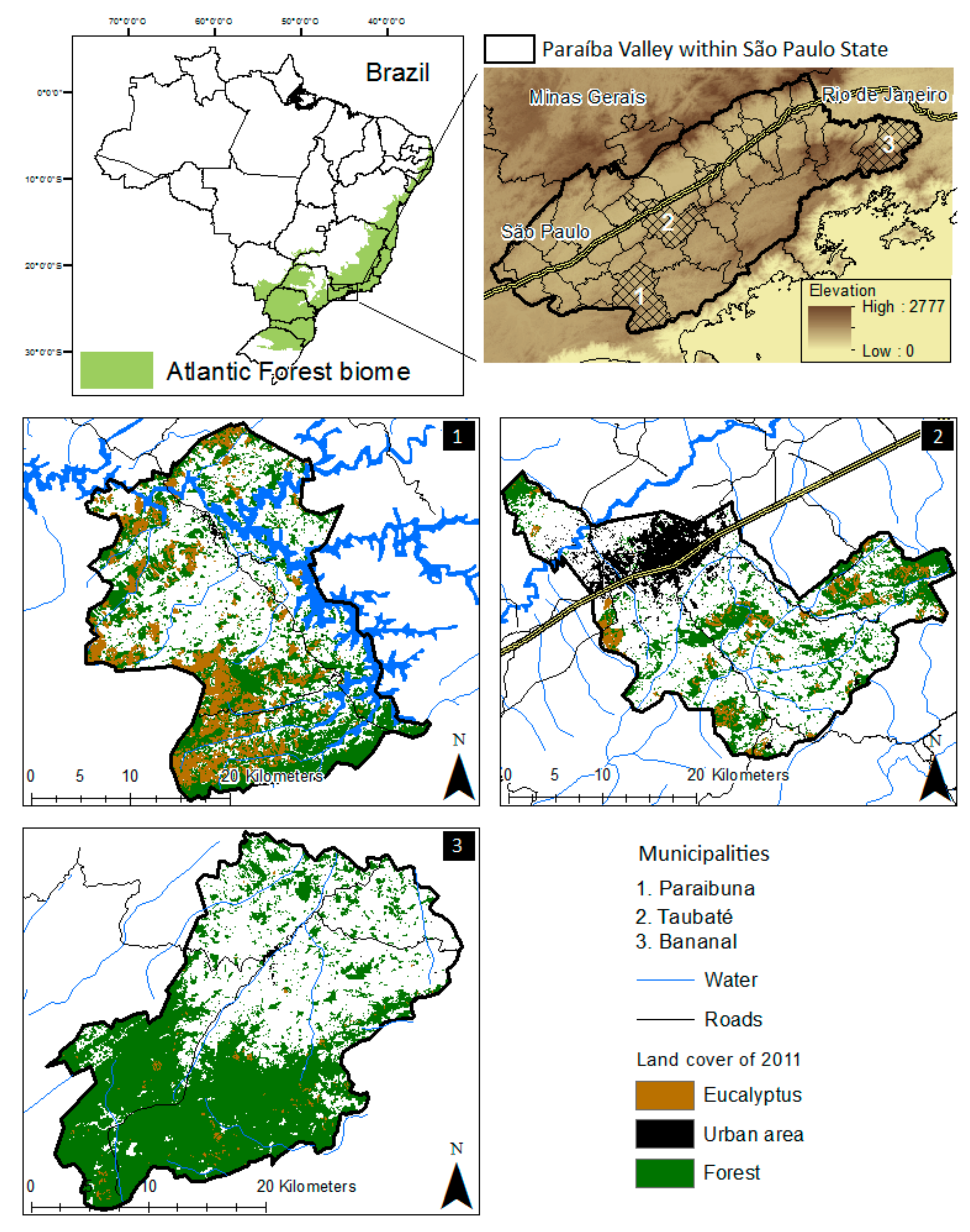
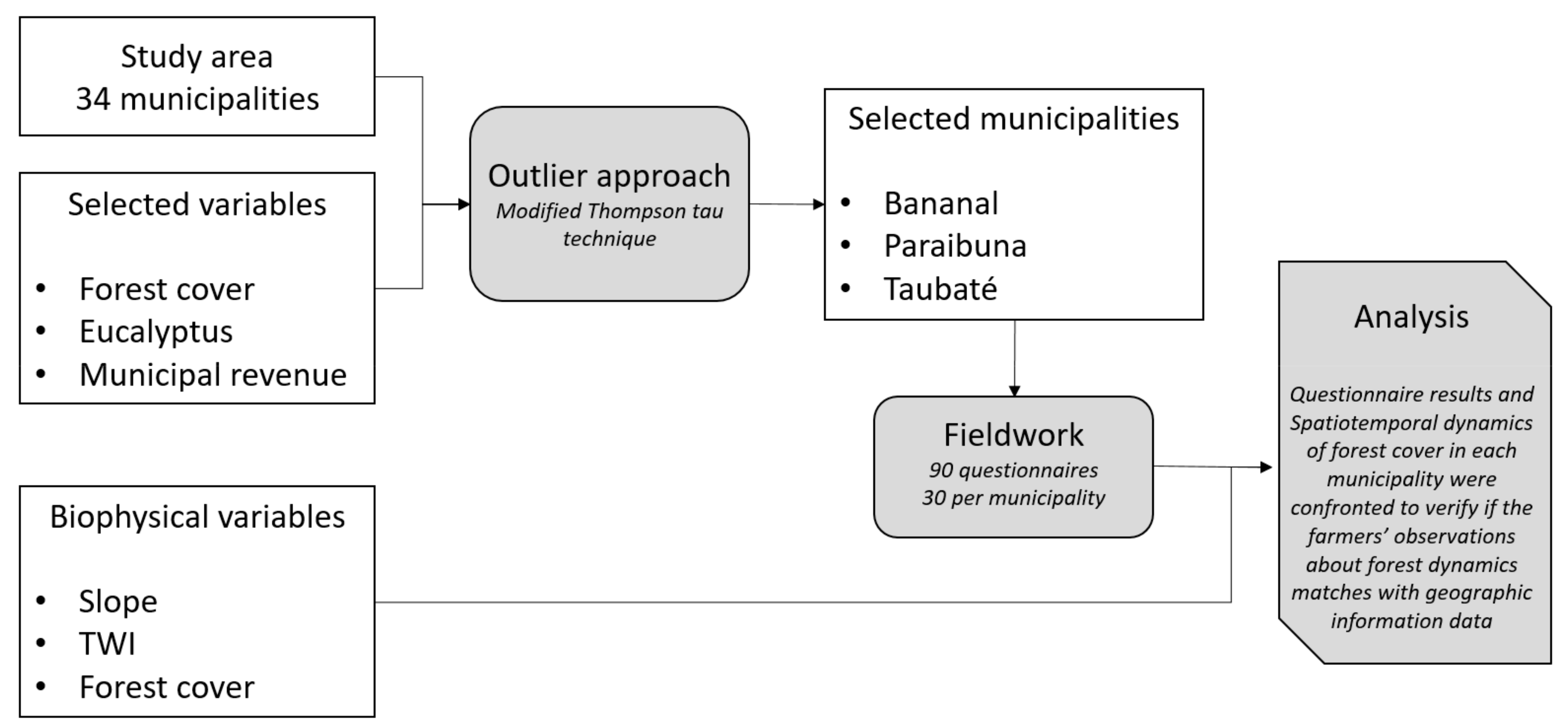
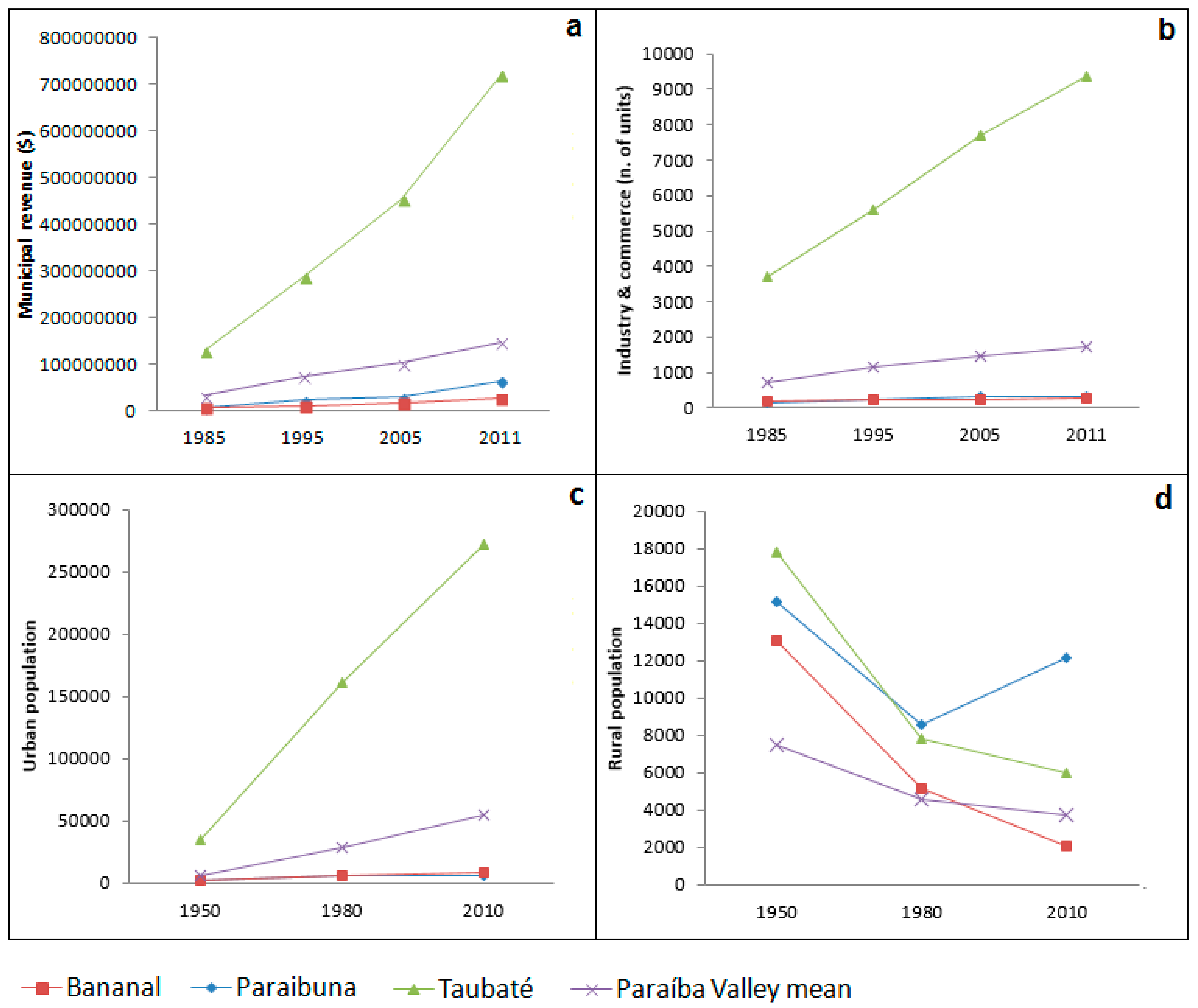
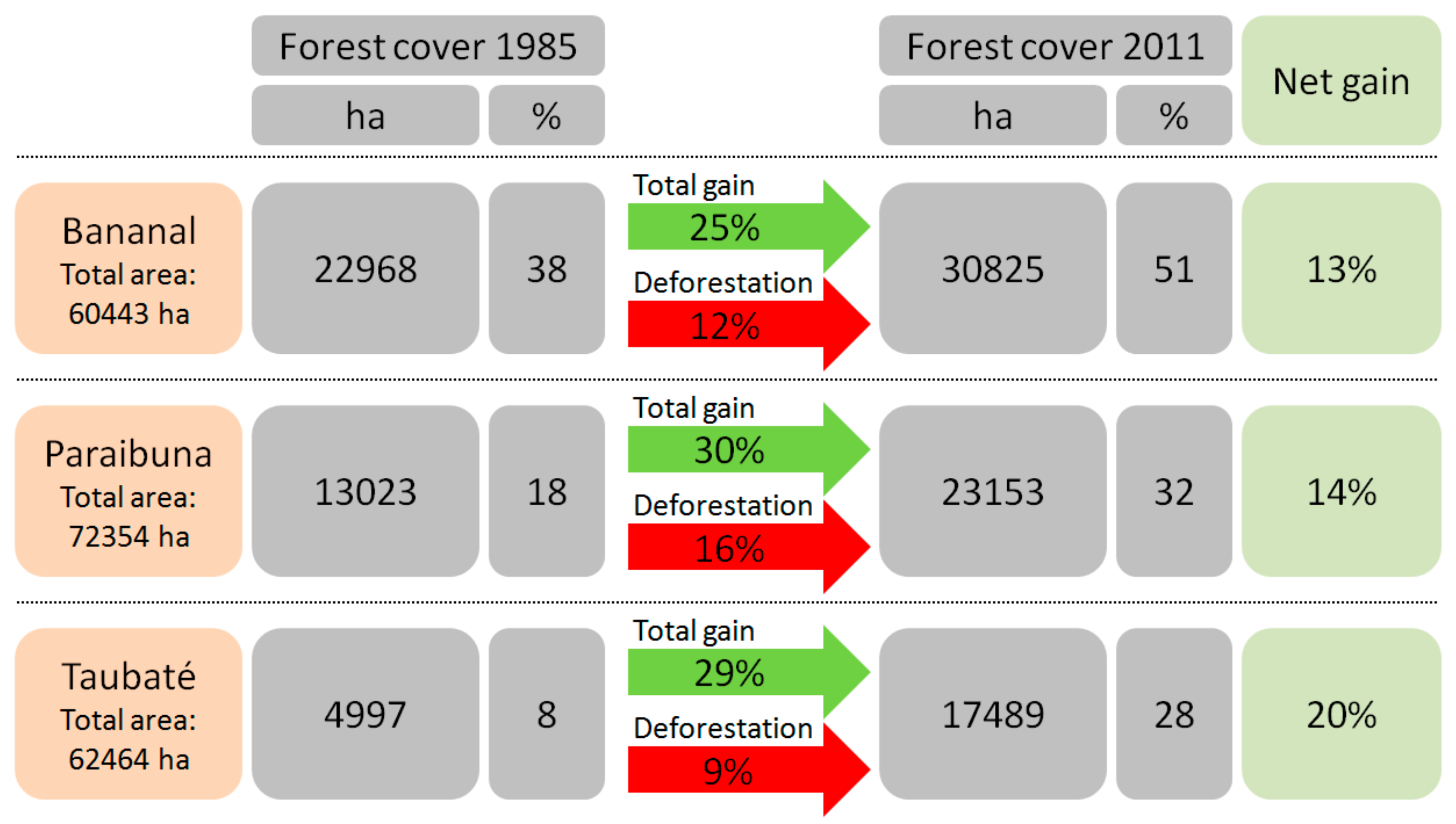
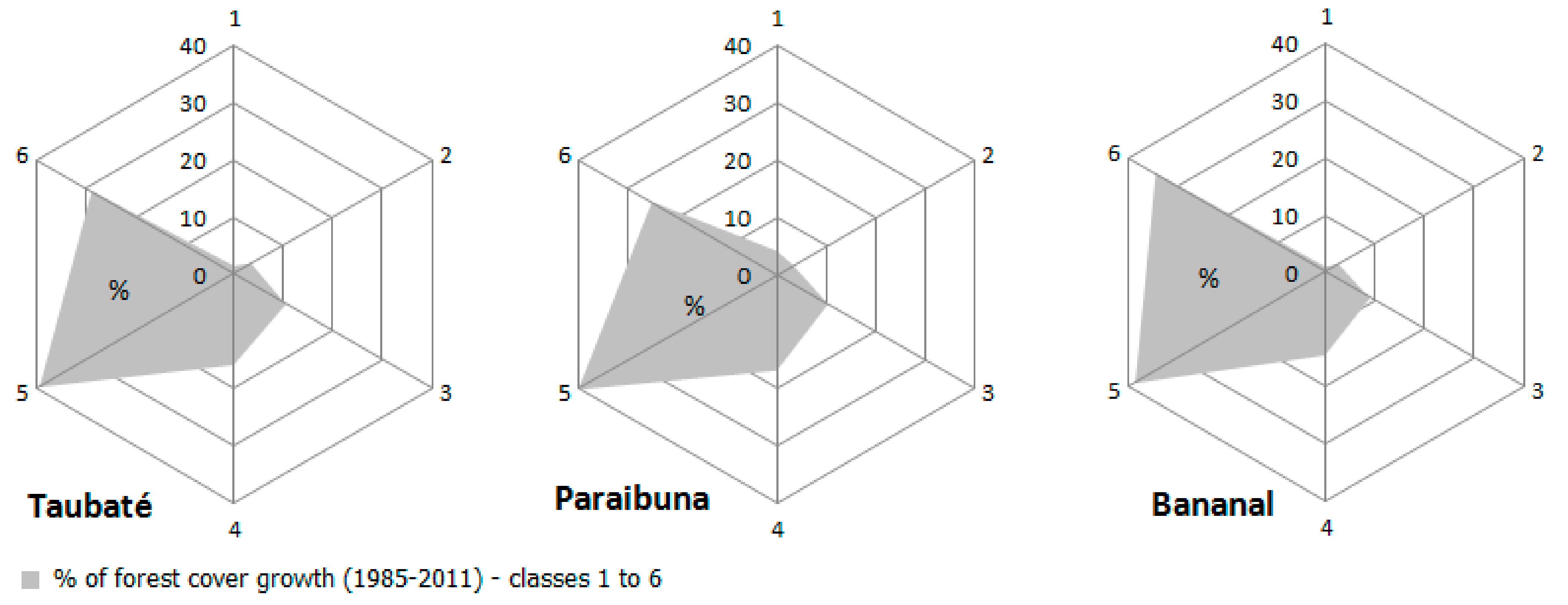
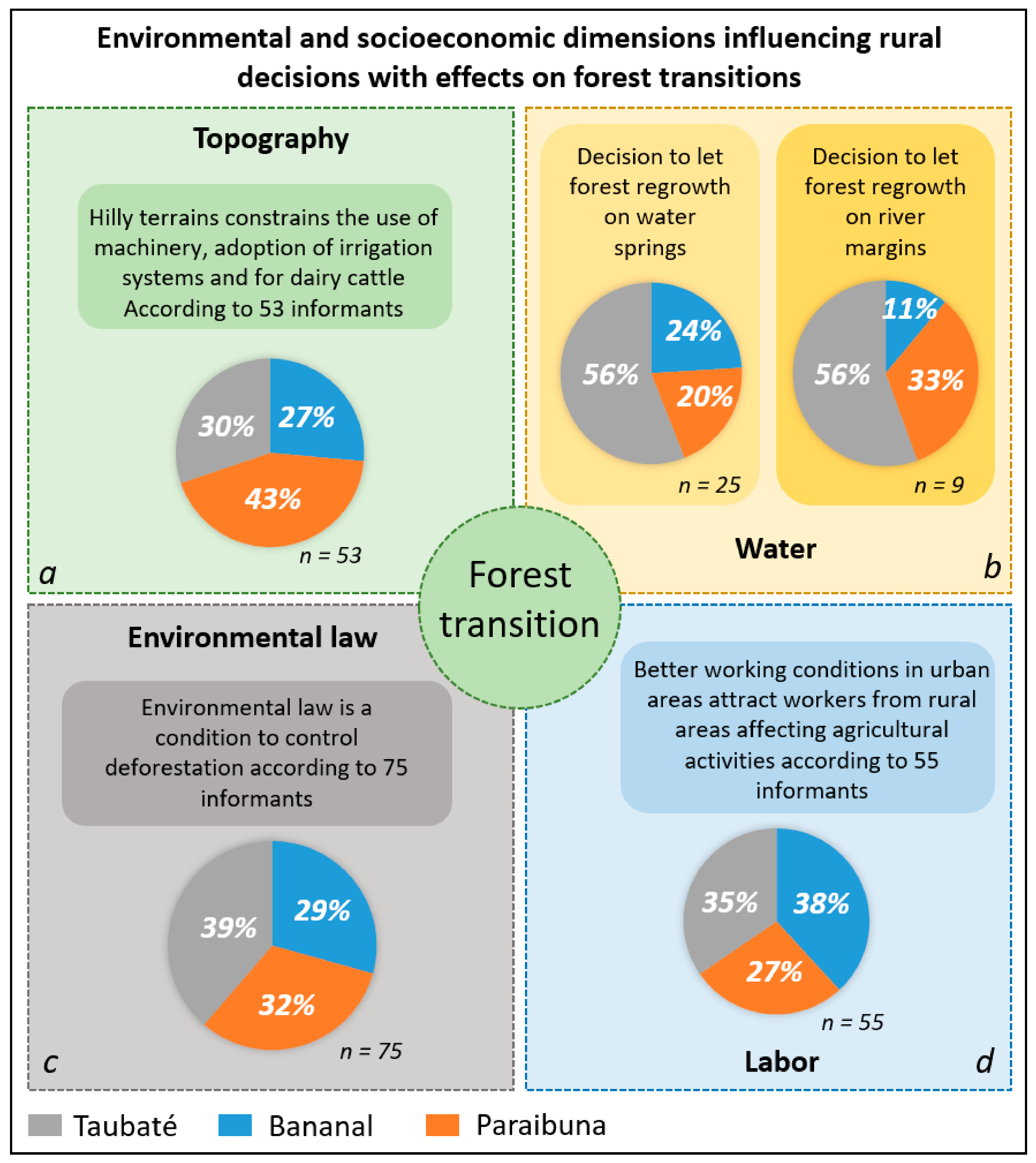
| Brief Description of Variables | Mean | Std. Deviation | |
|---|---|---|---|
| Forest ϕ | Mean variation of forest cover percentage within the municipality between 1985 and 2011 | 22.69287 | 11.21238 |
| Eucalyptus ϕ | Percentage of increase in eucalyptus plantation between 1985 and 2011 | 3.17766 | 3.832879 |
| Municipal revenue ɵ | Mean value of the revenue ($) per municipality between 1985 and 2011 | 89,891,625.22 | 198,996,234.1 |
| Outlier | Threshold * | Best Performance (Maximum Value) | Municipality | |
|---|---|---|---|---|
| Forest cover | 29.5 | 21.4 | 21.2 | Bananal |
| Eucalyptus plantation | 14.5 | 7.3 | 6.6 | Paraibuna |
| Municipal revenue | 995,218,101.3 | 381,555,379.2 | 335,204,038.3 | Taubaté |
| Rural Activities within the Property | Bananal | Paraibuna | Taubaté |
|---|---|---|---|
| Dairy | 9 | 6 | 12 |
| Dairy and buffalo | 1 | -- | -- |
| Dairy and pig | 1 | -- | -- |
| Dairy and leisure | 1 | -- | -- |
| Dairy and horticulture | -- | 1 | 3 |
| Dairy and beef | -- | 2 | 3 |
| Dairy and eucalyptus | -- | 2 | -- |
| Dairy, beef and eucalyptus | -- | 1 | -- |
| Dairy, beef, eucalyptus and rural tourism | -- | 1 | -- |
| Dairy, rural tourism, leisure and sausage | -- | 1 | -- |
| Dairy and cachaça | -- | 1 | -- |
| Dairy and rural tourism | -- | 1 | -- |
| Beef | 2 | 1 | -- |
| Beef and leisure | 2 | 1 | -- |
| Beef, leisure and cachaça * | 1 | -- | -- |
| Beef and cachaça | 1 | -- | -- |
| Leisure | 4 | 2 | 9 |
| Rural tourism | 2 | 2 | 1 |
| Rural tourism and leisure | 2 | -- | |
| Eucalyptus plantation | -- | 2 | 1 |
| Horticulture | -- | 3 | 1 |
| Fruits | -- | 2 | -- |
| Agroforestry | -- | 1 | -- |
| Abandoned ϕ | 4 | -- | -- |
| Farm Size (ha) | Bananal | Paraibuna | Taubaté | ||||||
|---|---|---|---|---|---|---|---|---|---|
| n * | Area | Age | n * | Area | Age | n * | Area | Age | |
| <100 | 18 | 825 | 56 | 20 | 981 | 54 | 18 | 630 | 60 |
| 100–300 | 7 | 1240 | 69 | 9 | 1120 | 58 | 11 | 1860 | 61 |
| 300–500 | 2 | 850 | 55 | 1 | 315 | 58 | -- | -- | -- |
| >500 | 3 | 2650 | 68 | -- | -- | -- | 1 | 600 | 46 |
| What Are the Future Expectations for Agricultural Activities in the Paraíba Valley? | Bananal (n *) | Paraibuna (n *) | Taubaté (n *) |
|---|---|---|---|
| New agribusiness cycles | -- | 4 | 2 |
| Expansion of eucalyptus | -- | -- | -- |
| No changes | 9 | 12 | 8 |
| Organic/agroecological farms | 1 | 1 | -- |
| Cattle and dairy intensification | 2 | 4 | 7 |
| Loss of agricultural productivity | -- | -- | 3 |
| Increase of agricultural productivity | -- | -- | -- |
| Support from government rural extension agencies | -- | -- | 2 |
| Decrease of agricultural activities | 15 | 9 | 8 |
| Decrease of dairy but increase of cattle for beef | 3 | -- | -- |
| What Is the Future of Livelihoods and Population in Rural Areas of the Paraíba Valley? | Bananal (n *) | Paraibuna (n) | Taubaté (n) |
|---|---|---|---|
| Decline of rural population | 4 | 3 | 2 |
| No changes | 9 | -- | 1 |
| Increase of rural population | -- | -- | -- |
| Increase of people living in rural areas with income from non-agricultural activities | 17 | 26 | 26 |
| Increase of family farming | -- | 1 | 1 |
© 2018 by the authors. Licensee MDPI, Basel, Switzerland. This article is an open access article distributed under the terms and conditions of the Creative Commons Attribution (CC BY) license (http://creativecommons.org/licenses/by/4.0/).
Share and Cite
Silva, R.F.B.d.; Batistella, M.; Moran, E.F. Regional Socioeconomic Changes Affecting Rural Area Livelihoods and Atlantic Forest Transitions. Land 2018, 7, 125. https://doi.org/10.3390/land7040125
Silva RFBd, Batistella M, Moran EF. Regional Socioeconomic Changes Affecting Rural Area Livelihoods and Atlantic Forest Transitions. Land. 2018; 7(4):125. https://doi.org/10.3390/land7040125
Chicago/Turabian StyleSilva, Ramon F. B. da, Mateus Batistella, and Emilio F. Moran. 2018. "Regional Socioeconomic Changes Affecting Rural Area Livelihoods and Atlantic Forest Transitions" Land 7, no. 4: 125. https://doi.org/10.3390/land7040125
APA StyleSilva, R. F. B. d., Batistella, M., & Moran, E. F. (2018). Regional Socioeconomic Changes Affecting Rural Area Livelihoods and Atlantic Forest Transitions. Land, 7(4), 125. https://doi.org/10.3390/land7040125







